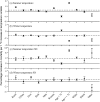Chronic effects of temperature on mortality in the Southeastern USA using satellite-based exposure metrics
- PMID: 27436237
- PMCID: PMC4951799
- DOI: 10.1038/srep30161
Chronic effects of temperature on mortality in the Southeastern USA using satellite-based exposure metrics
Abstract
Climate change may affect human health, particularly for elderly individuals who are vulnerable to temperature changes. While many studies have investigated the acute effects of heat, only a few have dealt with the chronic ones. We have examined the effects of seasonal temperatures on survival of the elderly in the Southeastern USA, where a large fraction of subpopulation resides. We found that both seasonal mean temperature and its standard deviation (SD) affected long-term survival among the 13 million Medicare beneficiaries (aged 65+) in this region during 2000-2013. A 1 °C increase in summer mean temperature corresponded to an increase of 2.5% in death rate. Whereas, 1 °C increase in winter mean temperature was associated with a decrease of 1.5%. Increases in seasonal temperature SD also influence mortality. We decomposed seasonal mean temperature and its temperature SD into long-term geographic contrasts between ZIP codes and annual anomalies within ZIP code. Effect modifications by different subgroups were also examined to find out whether certain individuals are more vulnerable. Our findings will be critical to future efforts assessing health risks related to the future climate change.
Figures



Similar articles
-
Climate change effects on human health: projections of temperature-related mortality for the UK during the 2020s, 2050s and 2080s.J Epidemiol Community Health. 2014 Jul;68(7):641-8. doi: 10.1136/jech-2013-202449. Epub 2014 Feb 3. J Epidemiol Community Health. 2014. PMID: 24493740
-
Seasonal Temperature Variability and Mortality in the Medicare Population.Environ Health Perspect. 2023 Jul;131(7):77002. doi: 10.1289/EHP11588. Epub 2023 Jul 5. Environ Health Perspect. 2023. PMID: 37404028 Free PMC article.
-
Air temperature-related human health outcomes: current impact and estimations of future risks in Central Italy.Sci Total Environ. 2012 Dec 15;441:28-40. doi: 10.1016/j.scitotenv.2012.09.056. Epub 2012 Nov 4. Sci Total Environ. 2012. PMID: 23134767
-
Changes in population susceptibility to heat and cold over time: assessing adaptation to climate change.Environ Health. 2016 Mar 8;15 Suppl 1(Suppl 1):33. doi: 10.1186/s12940-016-0102-7. Environ Health. 2016. PMID: 26961541 Free PMC article. Review.
-
[Extreme heat is a growing problem for global public health].Lakartidningen. 2016 Jul 22;113:DZTI. Lakartidningen. 2016. PMID: 27459087 Review. Swedish.
Cited by
-
Effects of long-term average temperature on cardiovascular disease hospitalizations in an American elderly population.Environ Res. 2023 Jan 1;216(Pt 3):114684. doi: 10.1016/j.envres.2022.114684. Epub 2022 Nov 2. Environ Res. 2023. PMID: 36334826 Free PMC article.
-
Regional-specific trends of PM2.5 and O3 temperature sensitivity in the United States.NPJ Clim Atmos Sci. 2025;8(1):12. doi: 10.1038/s41612-024-00862-4. Epub 2025 Jan 10. NPJ Clim Atmos Sci. 2025. PMID: 39803003 Free PMC article.
-
Long-Term Temperature Variability and Risk of Dyslipidemia Among Middle-Aged and Elderly Adults: A Prospective Cohort Study - China, 2011-2018.China CDC Wkly. 2022 Jul 1;4(26):561-564. doi: 10.46234/ccdcw2022.122. China CDC Wkly. 2022. PMID: 35919457 Free PMC article.
-
Temperature, Crime, and Violence: A Systematic Review and Meta-Analysis.Environ Health Perspect. 2024 Oct;132(10):106001. doi: 10.1289/EHP14300. Epub 2024 Oct 15. Environ Health Perspect. 2024. PMID: 39404825 Free PMC article.
-
Long-term exposure to air pollution, greenness and temperature and survival after a nonfatal myocardial infarction.Environ Pollut. 2024 Aug 15;355:124236. doi: 10.1016/j.envpol.2024.124236. Epub 2024 May 25. Environ Pollut. 2024. PMID: 38801880 Free PMC article.
References
-
- Stocker T. et al. IPCC, 2013: climate change 2013: the physical science basis. Contribution of working group I to the fifth assessment report of the intergovernmental panel on climate change (2013).
-
- Melillo J. M., Richmond T. T. & Yohe G. Climate change impacts in the United States. Third National Climate Assessment (2014).
-
- Patz J. A., Campbell-Lendrum D., Holloway T. & Foley J. A. Impact of regional climate change on human health. Nature 438, 310–317 (2005). - PubMed
Publication types
MeSH terms
Grants and funding
LinkOut - more resources
Full Text Sources
Other Literature Sources
Medical

